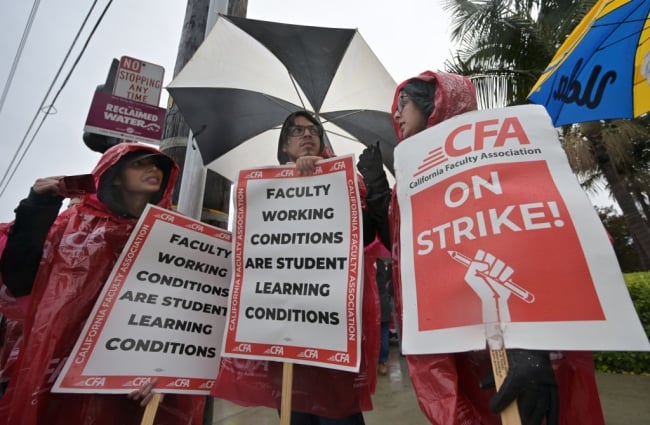You have /5 articles left.
Sign up for a free account or log in.

The strike is set to last through the end of this week.
Contributor/MediaNews Group/Long Beach Press-Telegram/Getty Images
Another massive higher education strike began Monday, with workers across the 23-campus California State University system walking off the job in pursuit of better pay, more mental health counselors for students, semester-long paid parental leave and other concessions.
By the end of the day, the union had called for the strike’s end. In a news release sent around 10 p.m. Pacific Standard Time, the union announced a tentative agreement with CSU that wouldn’t meet the union’s salary demand, but would provide 10 weeks of paid parental leave, up from six, along with other wins. The union said members would vote on the deal “in the coming weeks.”
“The collective action of so many lecturers, professors, counselors, librarians, and coaches over these last eight months forced CSU management to take our demands seriously,” Charles Toombs, president of the faculty association, said in the news release. “This tentative agreement makes major gains for all faculty at the CSU.”
In the Cal State system’s own news release, the new chancellor, Mildred García, said, “The agreement enables the CSU to fairly compensate its valued, world-class faculty while protecting the university system’s long-term financial sustainability. With the agreement in place, I look forward to advancing our student-centered work—together —as the nation’s greatest driver of social mobility and the pipeline fueling California’s diverse and educated workforce.”
CSU is the nation’s largest public four-year university by enrollment. The California Faculty Association (CFA), representing roughly 29,000 tenure-line instructional faculty members, lecturers, librarians, counselors and coaches within the system, had said the strike, its first systemwide one, would last through this week. This is the first week of spring semester classes on multiple California State campuses.
Neither Cal State nor the CFA provided numbers Monday for how many employees actually withheld labor. But William A. Herbert, executive director of the National Center for the Study of Collective Bargaining in Higher Education and the Professions, said it’s “the largest bargaining unit of faculty that have gone on strike in at least a decade.” He said data gaps at his center, located at the City University of New York’s Hunter College, prevent comparisons further back than that.
Herbert said it’s also the second-largest higher education worker strike over all, again judging by bargaining unit size, in at least 10 years—behind only the University of California strike in 2022. It’s been a little over a year since the end of that historic strike by unions representing 48,000 graduate assistants, postdoctoral scholars and other University of California workers.
Asked Monday why the CFA set a weeklong strike instead of an indefinite one, a union spokeswoman told Inside Higher Ed via email simply that “Lots of factors go into choosing the best method for striking. A five-day strike worked best for our members at this time.” The union didn’t provide an interview with a top statewide leader.
The union kept its strike date, which it set last month, despite the Cal State system announcing a 5 percent general salary increase for the union’s workers on Jan. 9, and despite Teamsters Local 2010, whose skilled-trades workers were supposed to walk out alongside the CFA Monday, backing out after announcing a tentative agreement with the university Friday.
John Caravello, a philosophy lecturer and vice president of the CFA chapter at Cal State’s Channel Islands campus, said the Teamsters were going to cover early-morning shifts to block deliveries, so the CFA had to assemble another wall of workers. At the Channel Islands campus, he said, the union got about 15 faculty members, a few Party for Socialism and Liberation members, and even a few Teamsters to block the loading docks.
“There were a couple picket crossers, but most of them turned around,” Caravello said of the trucks.
He said, “A good majority of our members are participating in striking and withholding labor.”
A CSU Channel Islands campus spokeswoman said, “We do not have data for how many classes faculty may have canceled or how many of them are not working today.”
Caravello said, “We’re out here to build a better university, whereas CSU management and the chancellor, they could easily stop this by meeting our demands” instead of “playing games” and “disrespecting us” at the bargaining table.
Earlier this month, at the same time that Cal State system leaders announced the 5 percent raise, they said they were done negotiating with the CFA, which had been pushing for a 12 percent increase this academic year. Officials at the system didn’t provide an interview or respond to emailed questions Monday, though it did send out a news release saying “the parties were in communication with each other over the weekend.”
Its leaders spoke at a news conference Friday and took a few questions from reporters.
“After more than seven months of negotiations, our faculty union continues to demand a 12 percent general salary increase for the fiscal year 23–24,” said Leora Freedman, vice chancellor for human resources for the Cal State system.
“If we were to agree to the increases that these unions are demanding,” she said, referencing both the CFA and the Teamsters, who were still set to strike at the time, “we would have to make severe cuts to programs, we would have to lay off employees, this would jeopardize our educational mission and cause hardship to many employees.”
Joseph Palermo, a history professor at California State University, Sacramento, said, “We’ve defended the budget of these schools forever … I think the budgets would be much lower and cut if we hadn’t been organizing and agitating all these years.” He said system leaders “should take into consideration the hard work we put in during the COVID crisis to keep the system running … It just doesn’t feel right to have the administration playing such hardball with us after we did so much to really shore up the system.”
Palermo said his own campus looks pretty “sealed off.”
“All the entrances are closed, and I don’t know how many people are getting through the lines,” he said.
A Sacramento State spokeswoman said, “All of our facilities are open” and “everything is functioning,” though she said providing numbers on canceled class sections or employees not working would be too preliminary at this point.
“We are advising students to reach out to their instructor or faculty member … and check to see if they are having class this week,” she said.
The call for more counselors was among the CFA’s nonsalary demands, Caravello said: “I have students who are having very deep mental health issues,” and he’s heard them say they sought out university counseling services and were told the next available appointment was two months away.
“That information is incorrect,” the CSU Channel Islands spokeswoman wrote. “We have openings for new clients next week. Since the Counseling & Psychological Services clinicians are counselor faculty, most of them are striking this week and therefore regular appointments were not scheduled for this week … We have not had more than a three-week wait for new clients unless they are not available at times we offer them.”
The union’s Monday night news release about the tentative agreement didn’t mention any university concessions on new counselors.
Among the “highlights” of the tentative agreement, the union listed “providing for a union rep” in faculty interactions with police and “improving access to gender-inclusive restrooms and lactation spaces.”
The highlights also include other pay increases, such as another 5 percent raise for faculty members on July 1, “contingent on the state not reducing base funding to the CSU.” But Cal State made a similar offer before the strike, and there weren’t further details in the release.




